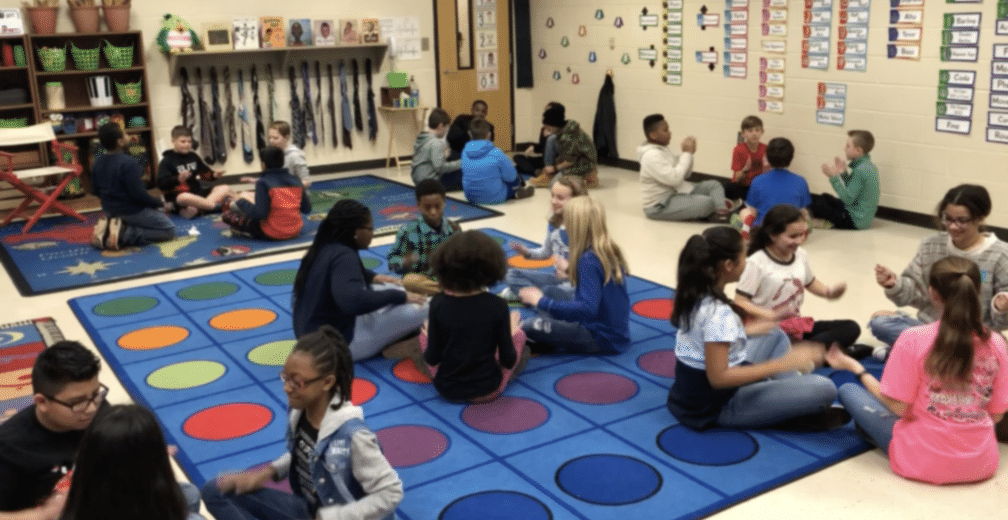
The Five Best Learning Centers for the Music Room
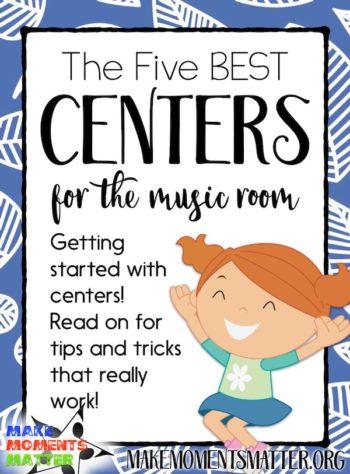 I think that every teacher has heard of “using centers” in the classroom and has probably been asked by an administrator, “How do you incorporate small group learning?” The concept of learning centers is pretty straightforward: students work in small groups (usually 2-5 kids each) to complete a specific task. Often students rotate and move from one “station” to the next throughout the course of the class. Each group of kids is encouraged to work independently of the teacher and learn with the other members of their small group.
I think that every teacher has heard of “using centers” in the classroom and has probably been asked by an administrator, “How do you incorporate small group learning?” The concept of learning centers is pretty straightforward: students work in small groups (usually 2-5 kids each) to complete a specific task. Often students rotate and move from one “station” to the next throughout the course of the class. Each group of kids is encouraged to work independently of the teacher and learn with the other members of their small group.
At first everything seems so clear and obvious: students working in small groups and rotating from one place to another. But how do you decide where those stations in the room should be placed? How many small groups should there be? 8 groups of 4 students? More or less in each group? Who chooses the groups? Is each center the same or does each rotation mean that kids complete a different task? How often do they rotate? Do they need to turn something in at the end of class? Why is this so hard!?
I find that the most daunting thing about learning centers is the questions of logistics – the how, where, why, and when. In this series of blog posts I’m hoping to work through some of those questions that so many of us have. I think that a lot of teachers would LIKE to include centers in the classroom but they get bogged down in the stress of creating things or planning the rotations. I’ll do my best to address some of those questions from what content/type of centers to include in a rotation, how to group kids together, incorporating technology, assessment, basic logistics, and organization.
In this blog post I’m going to talk about what I think are the five best activities you can use in your learning centers rotations. I’ll talk about instrument/playing centers, activity centers, reading spots, game stations, and listening centers. I’ve put a lot of thought into how to make centers work but I’ll freely admit that I don’t have all the answers and would suggest you do some searching through Pinterest and on other music education blogs. I love the work and thoughts of Aileen Miracle and Tracy King among others and am absolutely inspired by the blog posts they’ve already written on music learning centers.
#1 – Playing Centers – Instrument Time!
Ask any student what they love most about music class and 4 out of 5 will inevitably say, “Playing the instruments.” Press them on that and they probably won’t be able to tell you if they like the drums more than the xylophones or the egg shakers. They just love playing and don’t really care what it is they’re playing. Why not capitalize on that excitement by teaching/reinforcing important content in learning centers where students are encouraged to play instruments?
I really love leaving centers where students compose and arrange music to be played on an instrument. You could easily put some rhythm cards in a center with nonpitched instruments and leave a task like “Put the rhythm cards in an order you like, read the rhythm, and then speak/play the rhythm on your instrument.” This sort of activity is pretty low-stress for students and gives them experience playing, reading, and arranging.
What’s also great is that this sort of activity comes at nearly no cost to you. If you already have rhythm cards printed out you can just grab what you have and put them in centers. As for instruments to include in the center, you could easily leave indestructible and/or older nonpitched percussion instruments for students to play if you’re worried about kids playing too hard when working independently in this center. For example, this is a great place to put your wood blocks, tone blocks, old sandpaper scrapers, or rhythm sticks.
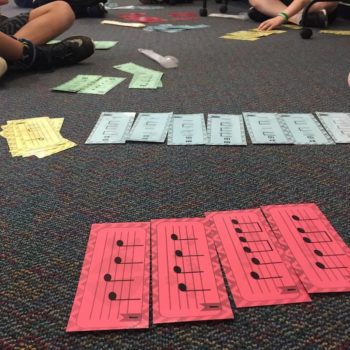 It’s easy to transfer this idea of “compose/arrange and then play” centers from nonpitched to pitched instruments. In fact, I leave recorder playing tasks for students in centers just like the ones mentioned above. I love to leave rhythm/melody cards in a center and ask students to arrange and read their own melody. I’ve found that students are more successful if I go through the process with the whole class before I turn them loose to do the activity on their own. So, in the classes leading up to a center day I might take one of the centers and go through the process with the whole class.
It’s easy to transfer this idea of “compose/arrange and then play” centers from nonpitched to pitched instruments. In fact, I leave recorder playing tasks for students in centers just like the ones mentioned above. I love to leave rhythm/melody cards in a center and ask students to arrange and read their own melody. I’ve found that students are more successful if I go through the process with the whole class before I turn them loose to do the activity on their own. So, in the classes leading up to a center day I might take one of the centers and go through the process with the whole class.
With an activity like recorder arrange/compose/play I teach students to take one card at a time first reading its rhythm, then note names, then finger practice while you say note names, and finally play. Once they’ve done this with the first card they can add an additional card and go through the same process with the new pattern. Add only one card at a time and make sure you can read the rhythm and do the finger practice before you play it. This teaches kids to work incrementally and piece through a process to figure out the music. I’ve found that it’s a lot easier for kids to work in a center this way than to give them a 12 measure sight-reading piece. While this way with individual cards is more work (in some ways) it makes them more successful in the long run. I actually did a Facebook video about how I teach and reinforce this process with recorder centers that I call “Fishin for a Melody.” If you’d like to learn more check out this link.
For instance, instead of just handing kids a wood block and letting them bang away, the wood block is accompanied with a task card that asks, “Where is the best place to play on the wood block? The end? The side? Near the opening? On a corner? Explore and find out.” The next card gives students a distinct rhythm and asks them to play the rhythm on the wood block. You can use this same process for any type of instrument in your classroom To make the process a little easier I’ve created some resources for instrument exploration centers with nonpitched percussion instruments, pitched percussion/Orff instruments, and also ukuleles!
#2 – Activity Centers to Reinforce Previous Learning
Spend just a few minutes searching Pinterest and you’ll feel like there almost too many options for work centers/activity stations. To me, any sort of activity where kids are asked to interactive with previously learned content/material falls into this category. Sometimes these centers are disguised as a game. For example, “Help the little panther find his way home by reading all the rhythms in this line.” Kids can move around manipulatives, compose music, practice writing notes and rests, read written music, and on and on.
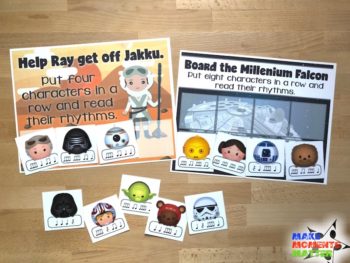 The one thing that I always try to think about when preparing learning centers like this is whether or not the students can successfully complete the tasks and interact with the content. Anything that I put in for them to use should be content that they already know so that they can truly work independently. I don’t want to give kids a concept or idea that they haven’t learned yet in some other way in class. They should only have questions about how the game/stations works, not about the content itself. If a kid has never seen a half note you don’t want to put that into the center because they will probably have a ton of questions that can’t be answered by their peers.
The one thing that I always try to think about when preparing learning centers like this is whether or not the students can successfully complete the tasks and interact with the content. Anything that I put in for them to use should be content that they already know so that they can truly work independently. I don’t want to give kids a concept or idea that they haven’t learned yet in some other way in class. They should only have questions about how the game/stations works, not about the content itself. If a kid has never seen a half note you don’t want to put that into the center because they will probably have a ton of questions that can’t be answered by their peers.
The best way to keep kids on task in centers is to give the easy activities that match their skill and interest level. If they’re faced with extremely difficult content then the center won’t feel successful and the kids will be much more likely to ignore the task at the center and just mess around or get off task. In a worst-case scenario they may end up with incorrect knowledge about half notes which will then have to be corrected later.
#3 – Reading Centers for Children’s Literature
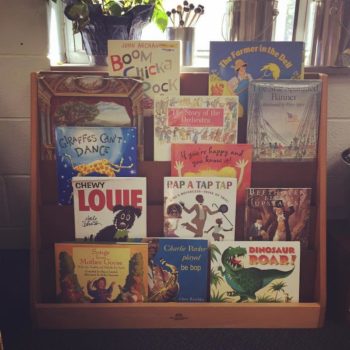 I have so many music-themed books in my classroom library that I honestly can’t get to them all during a normal school year. From Rap A Tap Tap to The Story of the Orchestra to Charlie Parker Played Be Bop and lots, lots more. Why not take some of those amazing books and put them in a center for kids to read? I love incorporating books that relate to the songs and games that we’ve been playing in music class throughout the year. Kids love finding connections to the content they already know and I like how it reinforces what we’ve done in class. If you have featured a book for a concert or special lesson in class kids will love to see it again and read through the story at their own pace.
I have so many music-themed books in my classroom library that I honestly can’t get to them all during a normal school year. From Rap A Tap Tap to The Story of the Orchestra to Charlie Parker Played Be Bop and lots, lots more. Why not take some of those amazing books and put them in a center for kids to read? I love incorporating books that relate to the songs and games that we’ve been playing in music class throughout the year. Kids love finding connections to the content they already know and I like how it reinforces what we’ve done in class. If you have featured a book for a concert or special lesson in class kids will love to see it again and read through the story at their own pace.
I think that experience picking up the book, looking through the pages, and getting some/all of the story is good experience. If a kid doesn’t get all the way through the book or if they don’t actually read the words on the pages I don’t think that the activity/center has failed in some way. Some of your kid will be at a super low reading level or might be English language learners. Just because they can’t read every word in the book doesn’t mean that they aren’t taking something really wonderful from the experience of choosing one of your options and flipping through the pages. On the other hand, some kids might zip through a book and could partner with another student to read together. Let them work through a couple books if they’d like and reread as needed. I have a Pinterest board filled with some of my favorite books for the classroom. I also have an Amazon Wishlist that I’ve started filling with some of my favorite pictures books, puppets, and other goodies.
#4 – Game-Based Learning Centers – Actually it’s LEARNING!
Kids love to take games that they already know and use them in the classroom. That’s why activities like Instrument Bingo are so popular, because kids already know how to play and win and are excited to transfer the skill they already know to use in this new setting. It doesn’t matter if it’s musical Old Maid, Uno, Go Fish, or Jenga… kids love taking games they know and playing the music version!
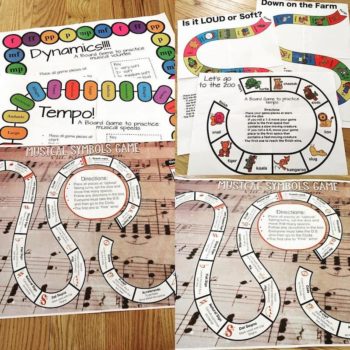
There are a lot of fun ideas you can find on Pinterest about how to take games you might already have stashed away in a closet and turn those into games to use in the classroom. I’ve tried a couple of those and would warn that they’re sort of a slippery slope. One minute you’re just cruising around Pinterest for ideas and the next you’re traveling from one Goodwill to another across town and calling your mother-in-law from the car to see if she might know someone with an old version of Monopoly that they’d be willing to donate to your classroom so you have all the pieces you need. I mean, at least that’s what I hear. Transforming old board games takes time and when pieces are gone they’re gone. Those games also take up a lot of space and sometimes take time to explain to students who have not played before.
I usually opt for musical card games that I can print out and create myself. I prefer these games because I can always go back and reprint something if I lose a card or set. I also like it because I can then choose which level of difficulty I want (sixteenth notes or half notes or dynamics or something else) and tailor the game to that.
A few years ago I bought Amy Abbot’s Music Game Bundle: Ultimate Set of Card and Board games on Teachers Pay Teachers and I haven’t looked back. This bundle includes games like Go Fish, Old Maid, Memory, Trouble and all of the games are themed around musical concepts. I’ve been printing and using these resources for centers, substitute days, open house nights, and a lot more. Totally got my money’s worth out of it and there are still resources I need to go back and print off to use in the future.
#5 -Listening Centers – Headphones On!
The last center I would encourage you to think about are listening centers where kids can experience musical examples from around the world. There are so many different types of music to include in listening centers but I would encourage you to give students examples of the best and brightest from music history. Include playlists with iconic symphonies (Mozart 40, Beethoven 9), famous jazz musicians (Louis Armstrong, Charlie Parker), big band hits, rock and roll favorites, and more.
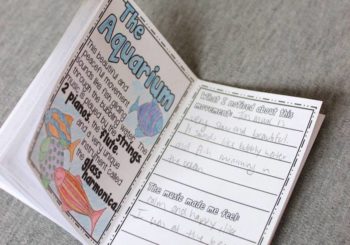
This is an opportunity for Haydn not Hamilton. I’m sure kids would love to turn on a CD player and find excerpts from “The Greatest Showman” but this is my one chance to expose them to new and exciting music. I would say that this is the time to pull out your “Music Listening/Music Appreciation” textbook from college and use those CDs that come along with them. You can give them some songs they might already know (O Fortuna from Orff’s Carmina Burana or Copeland’s Rodeo) and encourage them to listen to the whole thing and not just the 20 measures that they know from the commercials.
What should students do while they listen? In some instances I like to leave a listening activity. Cori Bloom has some really fantastic music listening worksheets on Teachers Pay Teachers that kids can interact with while they listen. If you’re not sure exactly how something like that would work check out this free resource from Cori to get the idea… and then go check out her music listening bundle. It’s totally worth it! That said, students don’t always need to be doing something. Sometimes just listening is important. They could work on coloring sheets while they listen, spin fidget spinners, play with legos, etc. I often like to play Sudoku or wash dishes while listening to podcasts. The sudoku doesn’t mean that I’m not listening to the content and in fact I think it helps me focus. Kids also benefit from those “keep your hands busy” activities.
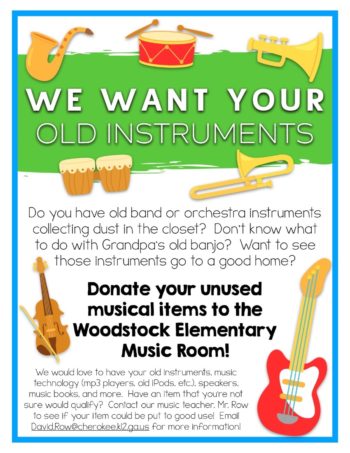 How can they listen? If you have CD players, iPads, mp3 players, or computers then kids can just plug in headphones and turn on the CD or iTunes playlist where your music is loaded. If you don’t have devices or headphones for student to use put a call out to your school community. I recently sent a note home to all my families asking for old instruments and music technology to use in the music room. I had a parent send in a brand new and completely unopened mp3 player that was a few years old but never used. Apparently it was a Christmas gift or clearance buy that was never put to use. If you don’t have the resources, just ask and see what shows up. Same for music for listening centers. Ask parents or other teachers if they have any classical music CDs they no longer want. Often people will have the “Best of Classical” cds that were purchased for $3 at Walmart and they’d be willing to let you have them.
How can they listen? If you have CD players, iPads, mp3 players, or computers then kids can just plug in headphones and turn on the CD or iTunes playlist where your music is loaded. If you don’t have devices or headphones for student to use put a call out to your school community. I recently sent a note home to all my families asking for old instruments and music technology to use in the music room. I had a parent send in a brand new and completely unopened mp3 player that was a few years old but never used. Apparently it was a Christmas gift or clearance buy that was never put to use. If you don’t have the resources, just ask and see what shows up. Same for music for listening centers. Ask parents or other teachers if they have any classical music CDs they no longer want. Often people will have the “Best of Classical” cds that were purchased for $3 at Walmart and they’d be willing to let you have them.
I hope that this gives you just a few ideas of things that you can put in learning centers for the music classroom. If you have any questions about the ideas mentioned above or you have other ideas you think might work for centers share those in the comments section. I’ll be adding more blog posts about centers soon, so if there’s a burning topic that you’d love to read more about send me and email or leave a comment below and I’ll try and include your ideas in my next blog post.

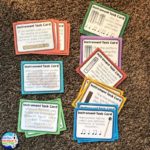
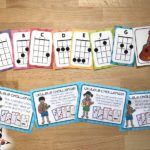
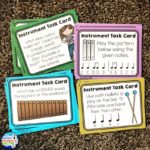
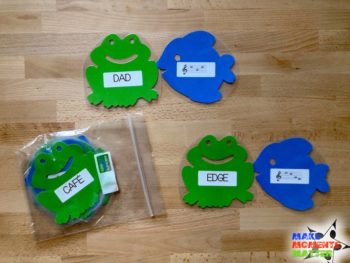
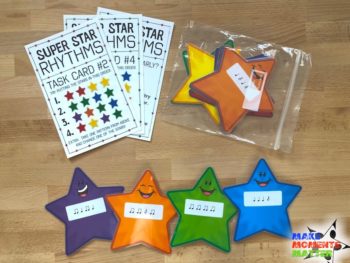
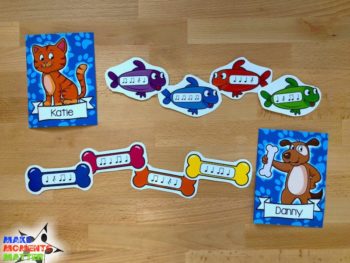

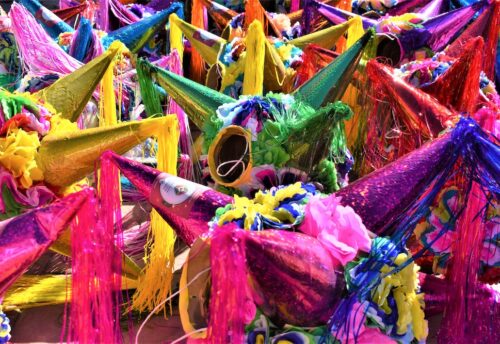
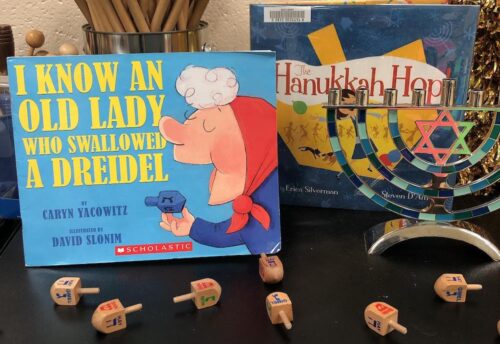
Pingback: How to plan elementary music centers in 9 easy steps